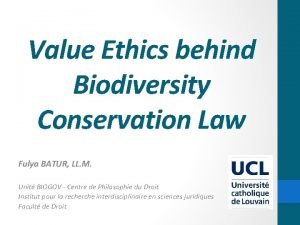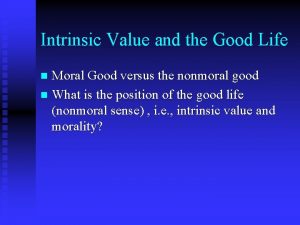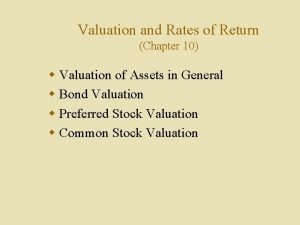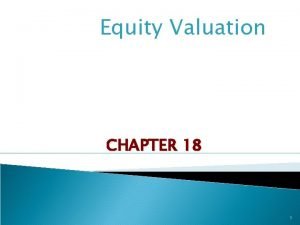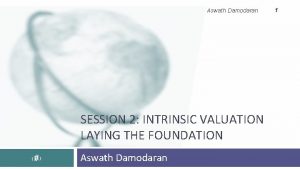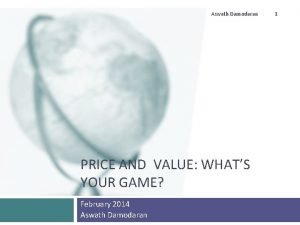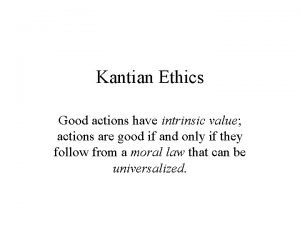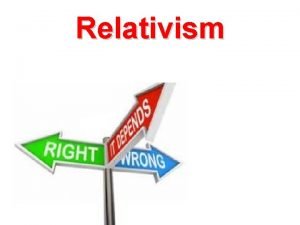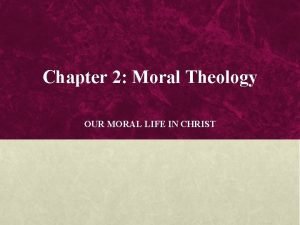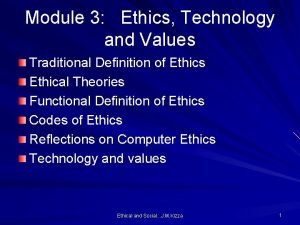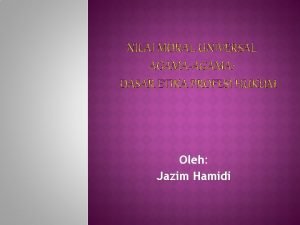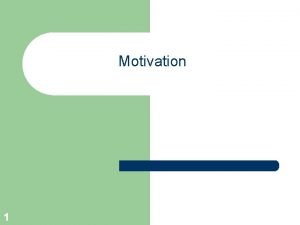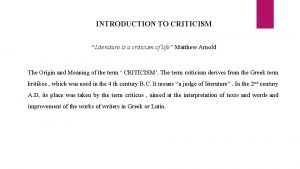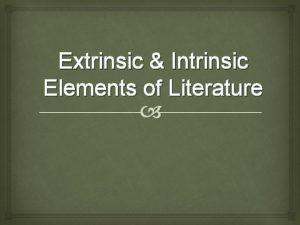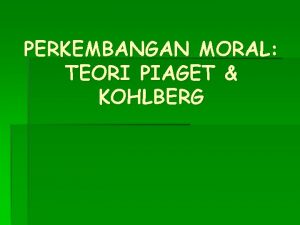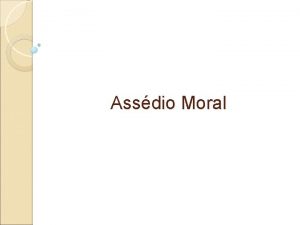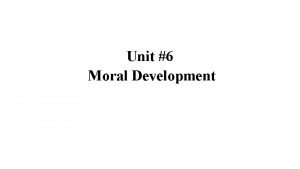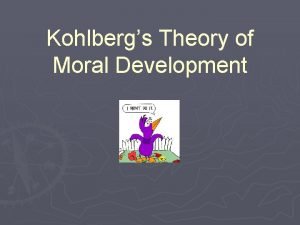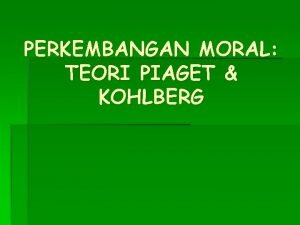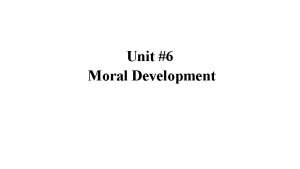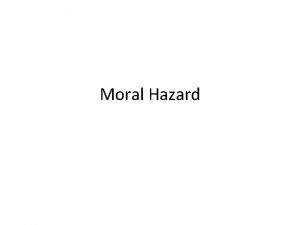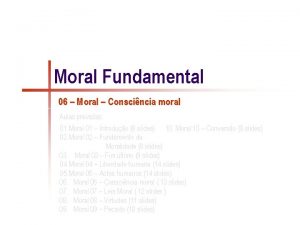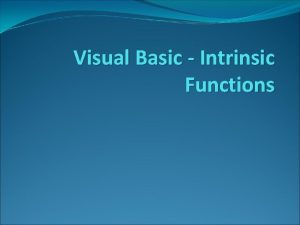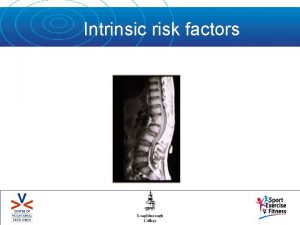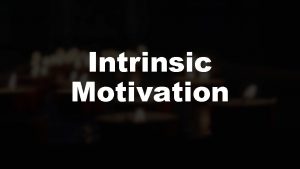Intrinsic Value and the Good Life Moral Good




































- Slides: 36

Intrinsic Value and the Good Life Moral Good versus the nonmoral good n What is the position of the good life (nonmoral sense) , i. e. , intrinsic value and morality? n

Nonmoral Values Utility values - good because of usefulness. n Extrinsic values - good because are a means to the good. n Inherent values - good because of contemplating them. n Intrinsic values - good because of own intrinsic properties. n

Nonmoral values continued. Contributory values - good because they contribute to the good life or parts of it. n Final Values - the final standard, the complete criteria for judging. n

What is the criteria to decide? Pleasure is good, the true goal of life is a pleasurable life - what one should aim at. . . n Hedonistic theory of nonmoral value. . a theory about the good, not the right. n

Hedonism n Pleasure is a term which refers to two distinct but related views. One a thesis in normative ethics, the other a generalization about human psychology.

Frankena. . . mixed deontology and hedonism 1. The good life is or should be a minister. n 2. The good life is minister to self and others. n u The pursuit is not just the good life, or good things, but to act justly, honestly, temperately, and benevolently. u Virtue is its own reward.

Meaning and Justification Frankena, Chapter 6 and other thoughts and writers. . .

Metaethics. . Moral philosophy, at best what ought to be. n Past moral philosophers - gave guidance on what to do, what to seek, and how to treat others. Plato, Aristotle, Epicurus, Hobbes, Spinoza and so forth tried to act as parish priests. n

Early Metaethicists Give guidance n Task: n u set forth systematic first principles and show it is possible to justify them. u Practical. . how to live and how one ought to live. u Goal…to actually become good.

Contemporary metaethicists Study of words and concepts n Object is not practice but knowledge…knowledge of the meaning of moral concepts. n Analyze and discuss the meaning of fuction of moral statements. n

Metaethics n Philosophical Analysis u clarification and understanding u Important aka Frankena F any reflective person should have understanding of the meaning and justification of one’s ethical jugements, especially considering this age.

Metaethics. . . n What is the meaning or definition of ethical terms or concepts like “right, ” “wrong”, “good” or “bad”? u What is the nature, meaning or function of judgments in relation to these or similar concepts? u What are the rules for the use of such terms and sentences?

Metaethics. . n 2. How are moral uses of such terms to be distinguished from nonmoral ones, moral judgments from other normative ones? u What is the meaning of “moral” as contrasted with “nonmoral”

Metaethics…. n 3. What is the analysis or meaning of related terms or concepts like “action” “conscience”, “free will” “intention” “promising” “excusing”, “motive” “responsibility”, “reason”, “voluntary”?

Metaethics. . . n 4. Can ethical and value judgments be proved, justified, or shown to be valid? u If so, how and in what sense? What is the logic of moral reasoning and of reasoning about value?

Metaethics in everyday life. Legal n Moral n Professional n

Legal Guiding ethical behavior. Standards that are stringently and strictly applied in all situations and for all people. n Specific penalities or consequences for actions which go against the rules. n The rules are clear about what is acceptable and what is not. Either the referee or cop monitors our behavior. n

Moral/Social Acceptability. Not as tight as legal, but provide society with a relatively firm set of rules for right and wrong. n What may be acceptable in LA may not be acceptable in Moscow, ID. n the acceptable standards vary among subcultures but usually have their own standards. n

Professional Most professional associations have some set of standards and guidelines for the conduct of members. n May be legalistic and strictly imposed or be loosely defined. n Standards reflect the values and beliefs of that group. n

Metaethical View of Teaching Moral Thinking. . Lawrence Kohlberg n Piaget n Lickona n

Components of Good Character u Moral Knowing – Moral Awareness – Knowing moral – – u Moral Valuing – Conscience – Self-esteem – Empathy – Loving the good – Self-Control – Humility values Perspective-taking Moral Reasoning Decision Making Self Knowledge u Moral Doing - Competence - Will - Habit T. Lickona, 1990

A Schematic of the process of Character Development from learning to doing. . . i Learning Past & Present Experiences. . Family, Friends, Teachers. . . Moral Instruction, moral reasoning. . . Environment Modeling Informal Learning Cognitive Dissonance Formal Instruction Moral Education The Triad of Character Development* Valuing Copyright 1994, Sharon Kay Stoll, Ph. D. Center for ETHICS* Knowing Doing *See, T. Lickona, Educating for Character

The Process of Developing Character through. . Cognitive Dissonance n Formal Reasoning Process – – – A Strong Philosophic Base Moral Reasoning Process Supported by Moral Development Theory Focused Toward A Content Area Proved, Pedagogical Skills – Instructor Education Program » Teaching methodology » Total curriculum » Assessment » Specific classes Copyright 1994, Sharon Kay Stoll, Ph. D. Center for ETHICS*

Cognitive MD based on: u What is considered right and fair? u What are the reasons for doing the right? u What are the underlying social-moral perspectives?

Cognitive Developmentalists Piaget, Kohlberg, Lickona. . .

Piaget’s Theory

Kohlberg’s Stage Theory u Level 1 = Preconventional u Level 2 = Conventional u Level 3 = Postconventional

Preconventional Level

Conventional Level

Post Conventional or Principled Level

Relativism…the constant ? ? n Frankena’s descriptive, metaethical and normative… u usually thought of in two senses. F ethical relativism F cultural relativism

Ethical relativsm n Because ethics is indefinable by its very nature, and because definitions lie in word usage, we really cannot understand the essence of the “moral” life. Because it can not be understood, therefore attempting to develop guidelines is senseless and illogical.

Cultural relativism n …each and every culture has a different set of demands and expectations of its moral community life. Because of such diversity, no standard set of guidelines or rules are possible. To develop such rules would violate the essence of the diverse world.

Frankena’s summation. . . n The Moral Point of View, pp. 113. u 1. One is making normative judgments about actions, desires, disposition, intentions, motives, persons, or traits of character. (Chapter one and two) u 2. One is wiling to universalize one’s judgments. (Chapter three)

n Moral Point… u 3. one’s reasons for one’s judgments consist of facts about what the things judged do to the lives of sentient beings in terms of promoting or distributing non-moral good or evil. (Chapters 3 and 4) u 4. when the judgment is about oneself or one’s own actions, one’s reasons include such facts about what one’s own actions and dispositions do to the lives of other sentient beings. (Chapters 4 and 5).

Why be moral? 1. What are the motives for doing what is morally right? n 2. What is the justification for doing what is morally right? n 3. What is the motivation for adopting the moral point of view and subscribing to the moral institution of live? n 4. What is its justification? n
 Fulya batur
Fulya batur Meta-ethics meaning and examples
Meta-ethics meaning and examples Preferred stock formula
Preferred stock formula Plowback ratio
Plowback ratio Ujt oscillator
Ujt oscillator F 520
F 520 Aswath damodaran intrinsic value
Aswath damodaran intrinsic value Aswath damodaran intrinsic value
Aswath damodaran intrinsic value Lcm-550x1 price
Lcm-550x1 price Attainx intrinsic value
Attainx intrinsic value Relative valuation vs dcf
Relative valuation vs dcf Intrinsic value
Intrinsic value Contoh value creation adalah
Contoh value creation adalah Moral realism
Moral realism Wave propagation in lossy dielectrics
Wave propagation in lossy dielectrics What happens if we leave afghanistan
What happens if we leave afghanistan Moral individu dan moral kelompok
Moral individu dan moral kelompok Moral de esclavos y moral de señores
Moral de esclavos y moral de señores Narrative text mouse deer and crocodile
Narrative text mouse deer and crocodile Lather and nothing else
Lather and nothing else Our moral life in christ chapter 2 study questions
Our moral life in christ chapter 2 study questions Aapacs
Aapacs Gap
Gap Technology and values
Technology and values Contoh moral universal
Contoh moral universal Definition of values in ethics
Definition of values in ethics Responsibility moral value
Responsibility moral value Good thoughts good deeds good actions
Good thoughts good deeds good actions Tom hello good morning
Tom hello good morning Good afternoon teacher
Good afternoon teacher Nothing compares to your embrace
Nothing compares to your embrace Good afternoon me
Good afternoon me Extrinsic reinforcement definition
Extrinsic reinforcement definition Explain intrinsic and extrinsic approaches to criticism
Explain intrinsic and extrinsic approaches to criticism Extrinsic element
Extrinsic element Intrinsic parameters of food
Intrinsic parameters of food Intrinsic and extrinsic elements of poetry
Intrinsic and extrinsic elements of poetry
